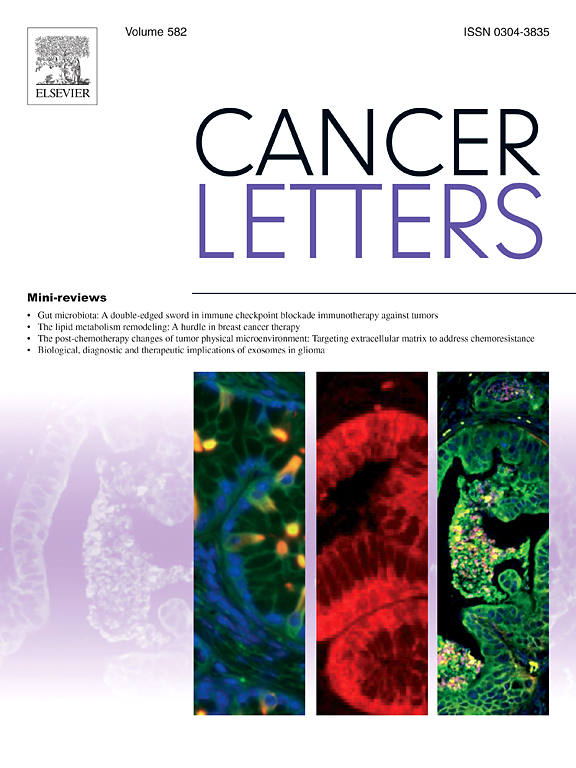缺氧诱导的NDRG1 c端多磷酸化损害其在肾癌中的抑瘤功能
IF 9.1
1区 医学
Q1 ONCOLOGY
引用次数: 0
摘要
缺氧是肿瘤侵袭转移的关键因素。N-myc下游调控基因1 (NDRG1)是包括透明细胞肾细胞癌(ccRCC)在内的多种癌症的侵袭和转移的已知抑制因子,但在缺氧调节的背景下仍知之甚少。值得注意的是,NDRG1的羧基端(c端)在一个独特的三串联重复序列中包含多个磷酸化位点,该序列对缺氧条件作出反应。然而,该区域磷酸化的精确调控机制和功能意义仍未被探索。我们的研究发现,缺氧触发NDRG1 c端多磷酸化,从而促进ccRCC的上皮-间质转化(EMT)。仅NDRG1敲低就足以诱导EMT,增强ccRCC细胞的侵袭和转移能力。具体来说,缺氧诱导的NDRG1 c端(328/330和346/356/366位点,被SGK1磷酸化)磷酸化增强了其sumo化和泛素化,导致NDRG1降解。NDRG1通常与E-cadherin和β-catenin形成复合物,抑制WNT信号传导;然而,该复合体在346/356/366位点被磷酸化破坏。体内研究表明,NDRG1敲低加速了肿瘤生长和肺转移,但磷酸化缺陷突变体的重新表达,特别是在328/330和346/356/366位点,显著减轻了这些促肿瘤作用。我们的研究表明,缺氧诱导的NDRG1的c端多磷酸化可促进其降解,激活WNT通路并驱动ccRCC恶性肿瘤。这些发现强调了NDRG1磷酸化在缺氧条件下ccRCC进展中的作用,并强调了潜在的干预治疗靶点。本文章由计算机程序翻译,如有差异,请以英文原文为准。

Hypoxia-induced NDRG1 C-terminal poly-phosphorylation impairs its tumor suppressor function in renal cell carcinoma
Hypoxia is a critical factor driving tumor invasion and metastasis. N-myc Downstream Regulated Gene 1 (NDRG1), a known suppressor of invasion and metastasis in various cancers including clear cell renal cell carcinoma (ccRCC), remains poorly understood in the context of hypoxic regulation. Notably, the carboxy terminus (C-terminus) of NDRG1 contains multiple phosphorylation sites within a unique three-tandem-repeat sequence that responds to hypoxic conditions. However, the precise regulatory mechanisms and functional significance of phosphorylation in this region remain unexplored.
Our research uncovered that hypoxia triggers poly-phosphorylation at the C-terminus of NDRG1, thereby facilitating epithelial-mesenchymal transition (EMT) in ccRCC. NDRG1 knockdown alone was sufficient to induce EMT, augmenting the invasive and metastatic capabilities of ccRCC cells. Specifically, hypoxia-induced phosphorylation at the C-terminus (sites 328/330 and 346/356/366, phosphorylated by SGK1) of NDRG1 enhances its SUMOylation and ubiquitination, leading to NDRG1 degradation. NDRG1 typically forms a complex with E-cadherin and β-catenin to suppress WNT signaling; however, this complex is disrupted by phosphorylation at the 346/356/366 sites. In vivo studies demonstrated that NDRG1 knockdown expedited tumor growth and pulmonary metastasis, but the re-expression of phosphorylation-deficient mutants, particularly at sites 328/330 and 346/356/366, significantly mitigated these tumor-promoting effects.
Our study demonstrates that hypoxia-induced C-terminal poly-phosphorylation of NDRG1 promotes its degradation, activating the WNT pathway and driving ccRCC malignancy. These findings underscore the role of NDRG1 phosphorylation in ccRCC progression under hypoxic conditions and highlight potential therapeutic targets for intervention.
求助全文
通过发布文献求助,成功后即可免费获取论文全文。
去求助
来源期刊

Cancer letters
医学-肿瘤学
CiteScore
17.70
自引率
2.10%
发文量
427
审稿时长
15 days
期刊介绍:
Cancer Letters is a reputable international journal that serves as a platform for significant and original contributions in cancer research. The journal welcomes both full-length articles and Mini Reviews in the wide-ranging field of basic and translational oncology. Furthermore, it frequently presents Special Issues that shed light on current and topical areas in cancer research.
Cancer Letters is highly interested in various fundamental aspects that can cater to a diverse readership. These areas include the molecular genetics and cell biology of cancer, radiation biology, molecular pathology, hormones and cancer, viral oncology, metastasis, and chemoprevention. The journal actively focuses on experimental therapeutics, particularly the advancement of targeted therapies for personalized cancer medicine, such as metronomic chemotherapy.
By publishing groundbreaking research and promoting advancements in cancer treatments, Cancer Letters aims to actively contribute to the fight against cancer and the improvement of patient outcomes.
 求助内容:
求助内容: 应助结果提醒方式:
应助结果提醒方式:


